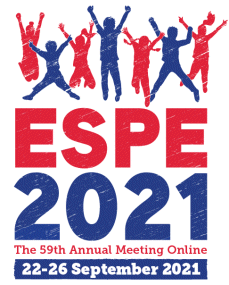
59th Annual ESPE (ESPE 2021 Online)
Online,
22 Sep 2021 - 26 Sep 2021

ePoster Category 1
Fetal Endocrinology and Multisystem Disorders A
hrp0094p1-71 | Fetal Endocrinology and Multisystem Disorders A | ESPE2021
Morning salivary cortisol and stress response in term and preterm infants hospitalized in the intensive care unit.
Olszewska Marta , Kwinta Przemko ,
hrp0094p1-72 | Fetal Endocrinology and Multisystem Disorders A | ESPE2021
Clinical characteristics of children with Congenital Hyperinsulinism: Results from the European Registries for Rare Endocrine Conditions (EuRRECa) Project
Plachy Lukas , Bryce Jillian , Mohnike Klaus , Gan Hoong-Wei , Shaikh Guftar , Rozenkova Klara , Mozzillo Enza , Maltoni Giulio , Navardauskaite Ruta , Casteels Kristina , Stuart Annemarie Verrijn , Dastamani Antonia , Empting Susann , Verkauskiene Rasa , Ahmed S. Faisal , Sumnik Zdenek ,
hrp0094p1-73 | Fetal Endocrinology and Multisystem Disorders A | ESPE2021
Minipuberty in born small for gestational age infants: a case control prospective pilot study
Pepe Giorgia , Calafiore Mariarosa , Velletri Maria Rosa , Corica Domenico , Aversa Tommaso , Mondello Isabella , Alibrandi Angela , Wasniewska Malgorzata ,
hrp0094p1-74 | Fetal Endocrinology and Multisystem Disorders A | ESPE2021
Pancreatic glucagon-like-peptide-1 receptor expression in congenital hyperinsulinism
Gubaeva Diliara , Proshchina Alexandra , Krivova Yuliya , Melikyan Maria ,
hrp0094p1-75 | Fetal Endocrinology and Multisystem Disorders A | ESPE2021
Congenital hyperinsulinism diagnosed after 12 months can have a monogenic aetiology
Hopkins Jasmin , Childs Alexandra , Hewat Thomas , Patel Kashyap , Houghton Jayne , Johnson Matthew , Laver Thomas , Flanagan Sarah ,
hrp0094p1-76 | Fetal Endocrinology and Multisystem Disorders A | ESPE2021
Hyperinsulinemic Hypoglycemia in a child with Peroxisomal Biogenesis Disorder due to a Novel PEX1 mutation
Lohiya Nikhil , Morris Andrew , Didi Mohamed , Senniappan Senthil ,
hrp0094p1-77 | Fetal Endocrinology and Multisystem Disorders A | ESPE2021
Real-Time Continuous Glucose Monitoring in the Management of Neonates with Persistent Hypoglycemia
Win Myat , Beardsall Kathy , Thankamony Ajay , Beckett Rowan ,
hrp0094p1-78 | Fetal Endocrinology and Multisystem Disorders A | ESPE2021
Hyperinsulinemic hypoglycemia due to biallelic mutations in the DNAJC3 gene
Gurpinar Tosun Busra , Menevse Tuba Seven , Esen Nisa , Turan Serap , Yesilyurt Ahmet , Guran Tulay , Bereket Abdullah ,
hrp0094p1-79 | Fetal Endocrinology and Multisystem Disorders A | ESPE2021
Concurrent hyperinsulinism and hypopituitarism in a 22 month old child due to a novel FOXA2 mutation
Kilci Fatih , Hurmuzlu Kozler Selen , Jones Jeremy , Ceylaner Serdar , Mine Cizmecioğlu Jones Filiz ,
hrp0094p1-80 | Fetal Endocrinology and Multisystem Disorders A | ESPE2021
Sphingosine 1- phosphate lyase insufficiency syndrome (SPLIS) as a cause of primary adrenal insufficiency and primary hypogonadism
Kwong Ruth , Maharaj Avinaash , Metherell Lou , Prasad Rathi ,



